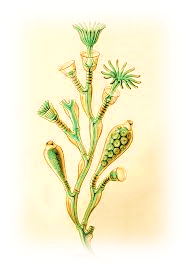Non-Chordata
Non-Chordata: Overview
The topic comprises questions based on Phylum Porifera, Coelenterata, Ctenophora, Platyhelminthes, Arthropods, Annelids, Aschelminthes and Hemichordates, etc. The questions given in this topic will help us to synthesize and master the concept.
Important Questions on Non-Chordata
What is the relationship between germinal layers and the formation of body cavity in case of coelomate, acoelomates and pseudocoelomates?
Name the following animal with cnidoblasts.

Give the characteristic features of the following citing one example of each
Urochordata and cephalochordata
Give the characteristic features of the following citing one example of each
Chondrichthyes and Osteichthyes
Differentiate between:
Polyp and medusa
Differentiate between:
Notochord and nerve cord
Differentiate between:
Acoelomate and pseudocoelomate
Match the following
| Column A | Column B |
| (a) Amphibia | (i) Air bladder |
| (b) Mammals | (ii) Cartilaginous notochord |
| (c) Chondrichthyes | (iii) Mammary glands |
| (d) Osteichthyes | (iv) Pneumatic bones |
| (e) Cyclostomata | (v) Dual habitat |
| (f) Aves | (vi) Sucking and circular mouth without jaws. |
Fill up the blank spaces appropriately
| Phylum/Class | Excretory Organ | Circulatory Organ | Respiratory Organ |
| Arthropoda | Lungs/Gills/Tracheal System | ||
| Nephridia | Closed | Skin/Parapodia | |
| Metanephridia | Open | ||
| Amphibia | Closed | Lung |
Sort out the animals on the basis of their symmetry (radial or bilateral) coelenterates, ctenophores, annelids, arthropods, and echinoderms.
What is the role of radula in molluscs?
Mention one example each for animals with chitinous exoskeleton and those covered by a calcareous shell.
Mention two modifications in reptiles required for terrestrial mode of life.
Give one example each for an animal possessing placoid scales and that with cycloid scales.
Which group of chordates possess sucking and circular mouth without jaws?
What is the role of feathers?
What is metagenesis? Mention an example which exhibits this phenomenon.
What is the importance of pneumatic bones and air sacs in Aves?
Identify the phylum in which adults exhibit radial symmetry and larva exhibit bilateral symmetry.
Match the column A with column B and choose the correct option
| Column I | Column II |
| A. Porifera | i. Canal system |
| B. Aschelminthes | ii. Water-vascular system |
| C. Annelida | iii. Muscular pharynx |
| D. Arthropoda | iv. Jointed appendages |
| E. Echinodermata | v. Metamere |
